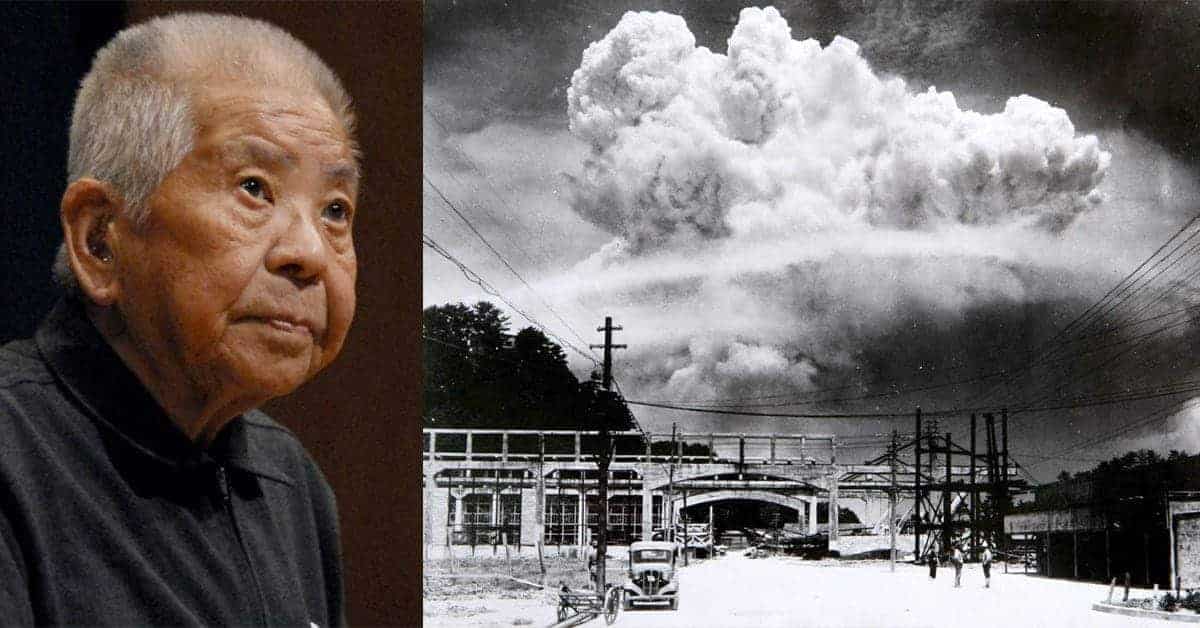Tsutomu Yamaguchi survived not one, but both atomic bombs dropped by the United States on the Japanese cities of Hiroshima and Nagasaki in August 1945. Yamaguchi was officially granted “hibakusha” (“atomic bomb victim”) status by the Japanese government in 1957, formally recognizing him as a survivor of the Nagasaki bombing. In January 2009, Yamaguchi applied for “nijῡ hibakusha” (“double atomic bomb victim”) status, and in March 2009, became the only officially recognized double survivor of both atomic bombings.
Tsutomu Yamaguchi was born on March 16, 1916, in Nagasaki. He joined Mitsubishi Heavy Industries in the 1930s, where he worked as a draughtsman. On the morning of August 6, 1945, Yamaguchi and two of his work colleagues, Akira Iwanaga and Kuniyoshi Sato were preparing to leave Hiroshima, where they had been working for the previous three months, designing an oil tanker. Firstly, they had to go to the Mitsubishi shipyard, prior to taking the train from Hiroshima to Nagasaki. While on the bus, Yamaguchi realized that he had forgotten his travel permit at his dormitory, so got off and made his way back to collect it. He took the next bus back and then began to walk the remainder of his journey to the shipyard.
Overhead, he heard the sound a single plane in the sky. It was an American B-29 bomber, the “Enola Gay,” named after its pilot, Colonel Paul Tibbets, mother. He looked up and saw the plane drop two parachutes. There was an intense flash and Yamaguchi’s naval air raid training immediately kicked in. He dove to the ground and rolled into an irrigation ditch, before locking his fingers over his eyes and plugging his ears with his thumbs. Seconds later, the 13-kiloton uranium atomic bomb, “Little Boy,” exploded. The force of the shockwave sent Yamaguchi whirling through the air before he crashed to the ground in a potato field.

Yamaguchi had been less than two miles from the epicenter of the explosion. When he regained consciousness, he could see “a mushroomed pillar of fire,” rising high up into the sky. Although it was morning, the ash and smoke from the raging fires darkened the sky. Dazed, Yamaguchi found a dug-out bomb shelter two hundred yards away and took refuge alongside two students who were sheltering there. They pointed out his injuries to him and Yamaguchi only then realized that his face and arms had been badly burned and that both of his eardrums had been ruptured by the explosion.
Yamaguchi stayed there for a couple of hours, recovering from the shock and trauma he had endured, before setting out to the Mitsubishi shipyard, where he met his colleagues, Iwanga and Sato. All three decided to cross the city and make their way back to their dormitory. On the way, they encountered the utter devastation of the aftermath of the nuclear explosion.
Buildings burned and charred bodies lined the streets. Yamaguchi recalled seeing dying children, their hair burned, completely naked, not crying but laying in silence, along the streets. The only sound he remembered was of the city burning. At one point, Yamaguchi, Iwanga and Sato had to wade through a river which teemed with corpses. It was like Hell on Earth. They found that their dormitory had been destroyed by the explosion so settled for the night in an air-raid shelter, before taking the train to Nagasaki.

